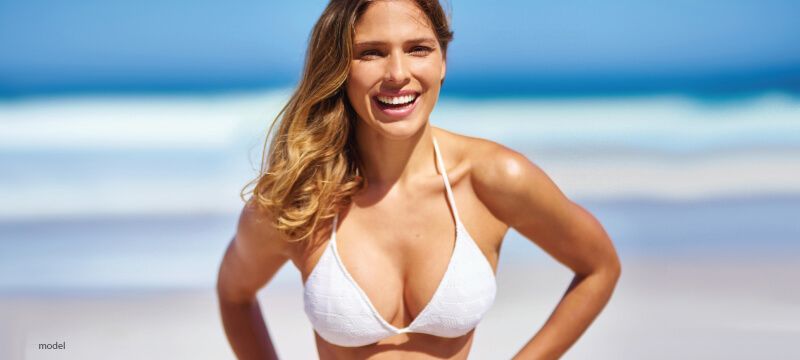Breast Implants Vs. Breast Augmentation Via Fat Transfer: Which Is Better?

The terms ‘breast augmentation’ and ‘breast implants’ are often used interchangeably. Fat transfer is an option for patients who want to enhance the size and appearance of their breasts but are not comfortable with implants.
Breast augmentation by fat transfer provides a less invasive alternative to breast augmentation using breast implants. The procedure involves use of liposuction to harvest fat from of other areas such as the flanks, thighs, hips, or abdomen. This fat is processed and carefully placed around the breast tissue to increase fullness. Fat transfer breast augmentation procedures deliver natural looking results with almost no scarring.
Below is a brief overview of breast augmentation fat transfer compares to traditional breast augmentation procedures that utilize implants:
Size
Depending on how much fat tissue is available for harvest patients can expect up to a cup size increase in breast volume. Some patients may not have enough donor fat for fat transfer breast augmentation to be a viable option.
In contrast, implant-based augmentation can deliver much larger increases in breast volume as breast implants are available in many different sizes. Thus, patients with limited fat tissue or patients who desire more dramatic results (large volume increases) will typically choose breast implants.
Look
Compared to implants, breast enhancement via fat transfer yields results that tend to be more natural in appearance. The reason for this is obvious: there’s no implant! Transferred fat behaves to the patient’s existing breast tissue resulting in more natural feeling and looking breasts.
It is important to understand that it is possible to create natural-looking and natural-feeling breasts with implants. In fact, more and more of our implant patients are seeking to look natural and youthful as we can make them. Patients can choose implants that are smaller in size or placed under the muscle to still achieve a less “augmented” result. This before and after case is a great example)
Body Contouring
Fat transfer allows for the added benefit of liposuction of other areas that may be of concern to the patient. Some common areas that benefit from body sculpting include the abdomen, thighs, flanks, arms, and under the chin.
Downtime
Fat transfer breast augmentation requires less downtime (recovery time) compared to breast implants. For a fat transfer, the longest period of recovery stems from the liposuction portion of the procedure, with most patients having to wait 2-3 weeks before resuming vigorous activity. Traditional breast augmentation patients typically need to wait 4-6 weeks, especially if for activities involving the chest and upper body.
Scarring
There is absolutely no scarring on the beasts associated with fat transfer augmentation. Patients may have tiny (< 1.0 cm) scars stemming from liposuction in the donor area but a skilled plastic surgeon will create these incisions in an inconspicuous area.
In contrast, implants require an incision, about an inch long, usually in the breast fold. The result of this incision is a fine scar, which often fades over time to be barely noticeable. There are also several different options for incision placement that allows for this scar to be hidden from view.
Longevity
The lifespan of a breast implant depends on several variables including patient satisfaction. In fact, some breast augmentation patients are be able to enjoy their implants for 20 years or longer without requiring a revision procedure.
Fat transfer breast augmentation is thought to be a permanent procedure. While typically 15-30% of transferred fat fails to survive the implanting process, the surviving fat integrates and receives blood supply from surrounding tissue to sustain itself, becoming living tissue in the breast.
Risks
Fat transfer risks include scarring, infection, and palpable lumps in the breast that may cause concern and require imaging. Surgeons will often obtain a baseline mammogram of the breasts before surgery. Breast implants risks include rupture, rippling and capsular contracture. These risks occur in a minority of cases and can be fixed through a revision procedure.

Great post! Is there any other viable breast augmentation options? I don’t really want implants but I am unsure if I have enough fat for this (I’m pretty petite). I know this sounds weird but is it possible to use donor fat from someone else?
Hi Jennifer,
Thanks for reading our post and submitting your great questions. At this point in time fat transfer and implants are really the only two viable options for breast augmentation. While you are petite, we would still encourage you to get an in-person consultation. It’s really the only way to make sure fat transfer breast augmentation is not viable.
If you are in the Austin area please give us a call to setup a consultation.
We hope that helps!
Thanks,
WD Staff